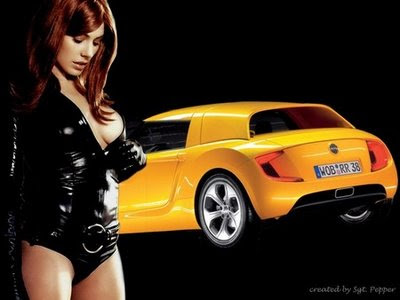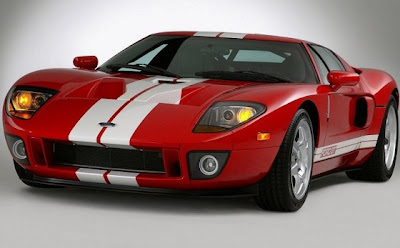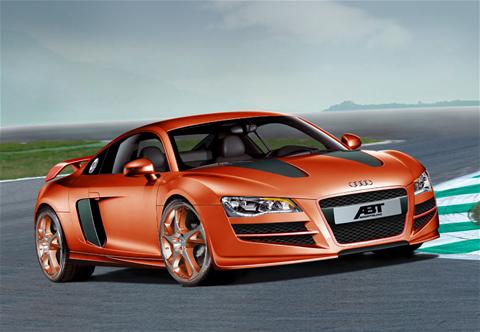
A recent article in the Wall Street Journal decried the loss of style in products by American car companies, principally General Motors. The author commented on the trend of outsourcing the design and manufacture of its small cars and stated: "Detroit's eagerness to attach its famous brand names to cars that were designed elsewhere may have something to do with its downfall: Cars get us around, of course, but they also, in their look and feel, capture a cultural outlook, a spirit, even a national identity." Style corresponds to "cool" and cool cars sell. But GM and Ford, and certainly Chrysler are a little short on cool these days and have been for several decades.

When I was in high school, somewhere back in the Pleistocene Epoch, American cars were all that there were. Oh, a stray Volkswagen, Vauxhall, or Fiat found its way onto American streets, but they were rare and largely ignored as oddities. Foreign-built cars were just not relevant. The American cars that followed World War II were refreshed versions of the pre-war designs and not very exciting. The left over designs from the Thirties and early Forties just didn't cut it in the cool department. (I once had a '46 Ford pickup, which was just a '40 Ford pickup with a new grill.) It took the American car industry a few years to re-tool from tanks and half-tracks to designing and building new passenger cars again.

But sometime in the mid-Fifties American car style took off and we got some very cool cars. The '53 Corvette, an American sports car made of the new material, fiberglass, the two seat '55 Ford Thunderbird, and the '55 Chevy hardtop, each with V-8 engines, were the first really exciting cars of our youth. And after those came a succession of mind-bending designs, a seemingly never-ending buffet of chrome, horsepower and tailfins. We discovered cars and girls at about the same time-and it was hard to tell which one was our first true love! For a teen-age boy this was Nirvana. Of course we couldn't afford to buy any of them, nor were most of us old enough to drive them, but we camped out every September when the new models hit the dealer's show rooms. The walls of our bedrooms were covered with car brochures. And later the big brother of a friend might take us cruising in a '63 GTO, a '62 Chevy SS 409, or a '64 Plymouth Hemi.

The mid to late Sixties were a car lover's paradise already and then we got the pony cars, the Mustang, the Camaro, and the Barracuda. Heavy on horsepower with short, light bodies just made for laying rubber up and down Oakland's East 14th Street between the two Pring's drive-ins, one at each end of the best cruising street in northern California!

By the way, gas, even super-premium, was about 36 cents a gallon and this being America and not post-war Europe, we had all we could burn. Gas wars between rival stations would bring the price even lower (I remember 19.9 cents/gal!) and we filled up and kept the pedal to the metal, as was the idiom of the day. A few foreign cars started showing up in the Fifties and Sixties-the Toyopet from Japan, MGs from England, and the VW Bug became a bit more noticeable. The bug eventually became a cult car and a hippie symbol, so it was ok, but other than that, American cars were the Kings of Cool. Nash Ramblers were preferable to anything Japanese, but maybe that was because the seats folded all the way back into a double bed. My friend Kenny owned one and we paid him two six packs and a full tank of gas to let us take it on dates.

But we came of age with a jolt. First there was the Viet Nam War, and then in 1973, the Arab Oil Embargo. These events were like the lights coming on in a theater at the end of a fabulous movie and all you could see were empty popcorn boxes, candy wrappers and a blank screen. The oil boycott was on and the car party was over--big time. Gas prices shot up over 50% in just a few months between mid-1973 and early 1974. But scarcity ruled the day, and at one point there was very little gas to buy at all. The crisis ended a year after it began, but the effects of scarcity, artificial or otherwise, and the resulting high prices are still being felt today and it was the beginning of the end for the American car culture. All of a sudden Toyotas and Datsuns and Volkswagens were flooding the country and people were buying them as fast as the dealers could get them in. We were scared out of our wits that we wouldn't be able to get enough gas for our cars. These foreign cars were gas sippers compared to the average American V-8, and we couldn't buy them fast enough.

American car companies had been trying to compete at some level with this foreign import threat for a decade-the Ford Falcon and the Chevrolet Corvair were examples, but US car companies didn't have the same experience with small car designs as did our Japanese and German competitors who had survived the post-war period of shortages and high fuel prices by learning how to build good, fuel efficient small cars. American companies "discovered" the 4 cylinder and the V-6 engine and front wheel drive some time in the Seventies, but cars like the Chevy Nova and the Ford Maverick were disasters, and it just got worse. The American love for big, fast cars just couldn't be translated into the designs of small, fuel-efficient automobiles from the same companies that they had venerated for years. Ford and GM didn't have the talent to compete with Asia and Europe in the small car department.

But it was worse than that. By turning their attention to small cars and eventually trucks, American car companies lost their way. They forgot how to put style into regular size coupes and sedans. Cars became an afterthought, especially when the SUV craze allowed manufacturers to make huge profits on trucks. But Europe and Japan didn't stop with small cars. They improved their bigger, more expensive versions as well. Mercedes, Lexus, Jaguar, and BMW, not to mention Porsche and Ferrari, became the lust objects of a new generation. These cars were stylish. They were cool. American car companies floundered with small cars, and now their regular offerings, for years the mainstay of generations of car lovers, were ignored and faded into oblivion in favor of trucks.

Mercedes, BMW, and Jaguar don't build pickup trucks-at least not for sale in this country. Oh yes, some commercial vehicles, but the car-the four door sedan, the coupe big and small, are their mainstay and have been the luxury leaders for two decades now. Their SUVs, with some exceptions, are really crossovers based on car chassis with the ride and handling to match. While American car companies were obsessed with big, high-profit trucks, the Germans and the Japanese snuck in and stole their bacon. Having ignored cars for so long, it's not surprising that the American car companies have been unable to catch up. Cadillac has the closest thing to a foreign sport sedan, but it may be too late. Not too late for the engineering to catch up. Too late to recapture the cool, the desire, and the public taste for American iron. GM and Ford lost their sense of style. The American public has changed and the American car companies have been left behind. Ford owned Jaguar. It should have absorbed Jaguar's style into its main line of cars. But when trucks stopped selling, they sold Jaguar rather than use its unique blend of style and performance to recreate an American passion for its cars.





0 comments:
Post a Comment